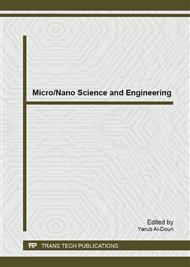p.469
p.474
p.481
p.486
p.490
p.495
p.500
p.505
p.510
SERS-Active Nanomaterials: A New Dimension in Sensing Nucleic Acids
Abstract:
Detection of nucleic acids has wide ranging applications in biomedical, food, forensic and environmental sciences as well as in anti-bioterrorism. The development of highly sensitive, cost-effective and miniaturized biosensors and biochips requires advanced technology coupled with fundamental knowledge in chemistry, biology, and material sciences. In general, sensors and chips feature two functional components: a recognition element that provides selective/specific binding with the target analytes and a transducer component for signaling the binding event. An efficient sensor relies heavily on these two components for the recognition process in terms of response time, signal-to-noise ratio (S/N), selectivity, and limits of detection. Thus designing biosensors with higher efficacy depends on the development of novel materials to improve both the recognition and transduction processes. Surface enhanced Raman scattering (SERS)-active nanomaterials feature unique physicochemical properties that can be of great utility in creating new recognition and transduction processes for chemical and biological sensors, improving the S/N ratio by miniaturization of the sensor elements. The surface of SERS-active nanomaterials needs to be tailored and decorated for immobilizing marker biomolecules and integration with chromophores. This paper has extensively reviewed various SERS-active nanomaterials along with their synthesis, surface modification and characterization schemes for nucleic acid sensing applications with atomic precision.
Info:
Periodical:
Pages:
490-494
Citation:
Online since:
April 2014
Authors:
Price:
Сopyright:
© 2014 Trans Tech Publications Ltd. All Rights Reserved
Share:
Citation:


